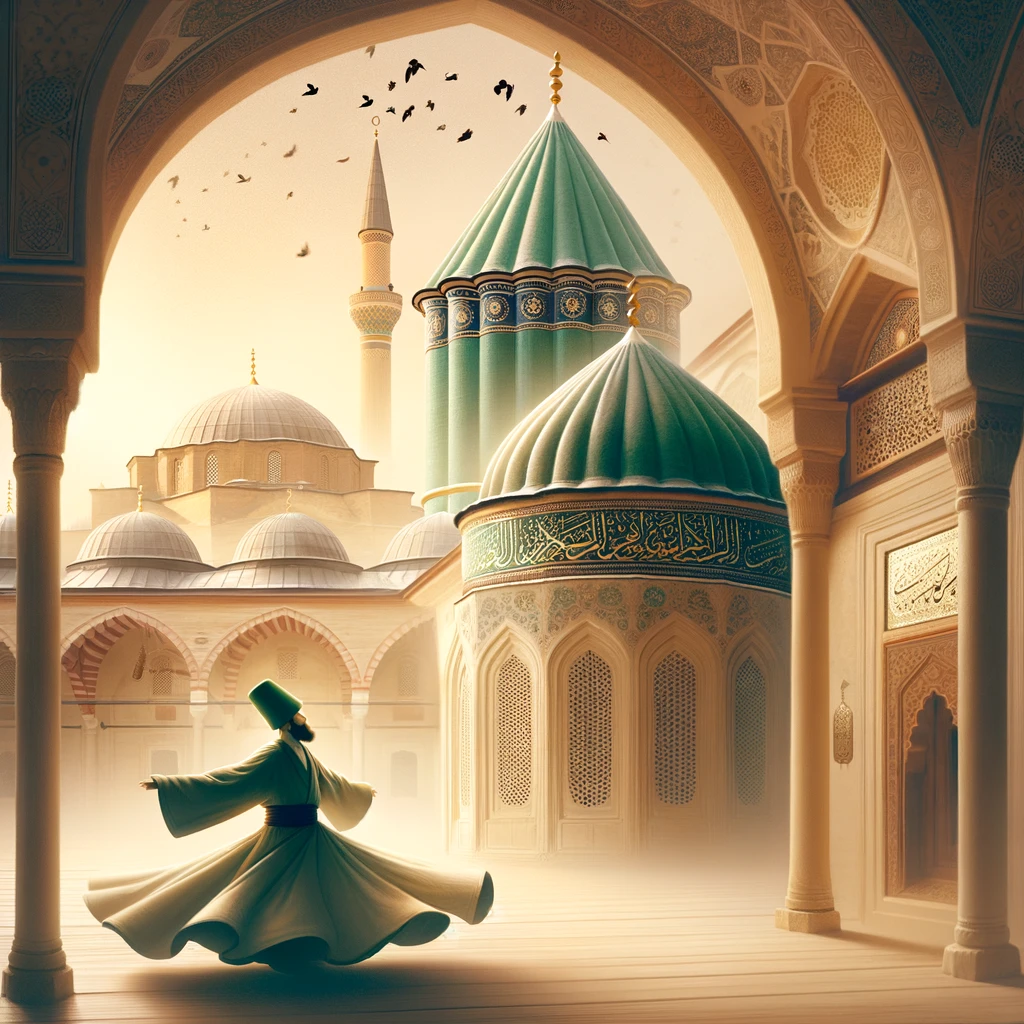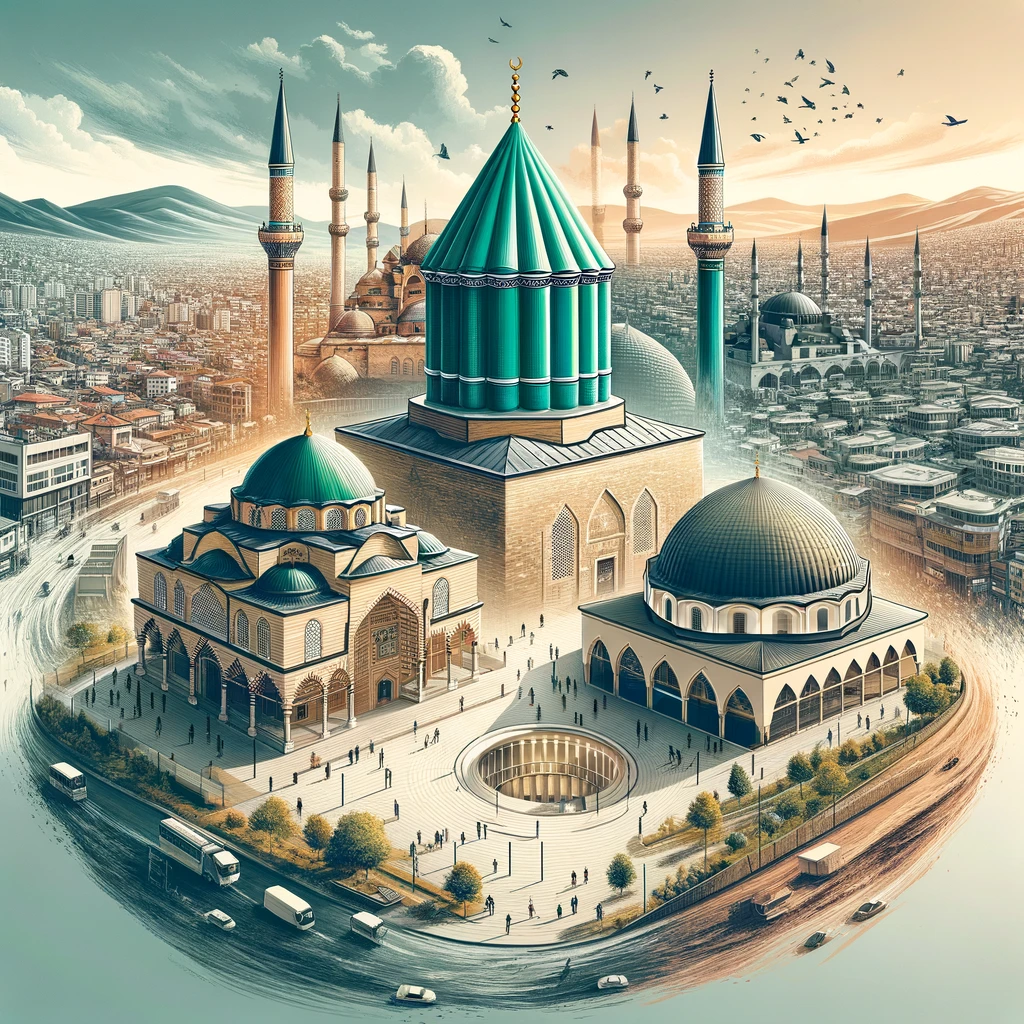Konya, one of Turkey’s oldest continuously inhabited cities, is a blend of spiritual history, rich culture, and breathtaking architecture. Known as the city of Rumi and the birthplace of the whirling dervishes, Konya offers a journey through time, where ancient traditions seamlessly blend with modern life. This blog post takes you through the heart of Konya, exploring its historical sites, spiritual significance, and unique cultural experiences.

The Spiritual Heart of Konya: Mevlana Museum and the Whirling Dervishes
Konya, a city steeped in history and spirituality, is home to one of Turkey’s most revered sites – the Mevlana Museum, also known as the Mevlana Rumi Museum. This sacred place is not just a museum; it’s a journey into the soul of Sufism, immortalized by the teachings of Jalal ad-Din Muhammad Rumi, a 13th-century Persian poet, Islamic scholar, and Sufi mystic.
Mevlana Museum: A Sanctuary of Peace and Love
- History: Originally Rumi’s lodge (dervish monastery), the museum was transformed from his place of burial. Rumi’s tomb is a place of pilgrimage, attracting thousands from around the world.
- Architecture: The museum, with its iconic green dome and Seljuk architecture, stands as a testament to the spiritual significance and artistic beauty of the era.
- Inside the Museum: It houses artifacts of Rumi’s life, historical manuscripts, and items associated with the Mevlevi order, providing insight into the rich Sufi culture.
Whirling Dervishes: The Dance of the Soul
- Sema Ceremony: A form of dhikr (remembrance of God), the Sema represents a mystical journey of man’s spiritual ascent to perfection. Dervishes whirl in white flowing gowns, symbolizing death, and tall felt hats, representing tombstones.
- Philosophy and Symbolism: The ceremony is deeply symbolic – from the turning of the right hand towards the sky, ready to receive God’s beneficence, to the left hand turned toward the earth, directing what’s received to humanity.
- The Mevlevi Order: Followers of Rumi, the Mevlevi order, believe in performing Sema as a path to reach God, emphasizing love, tolerance, and the abandonment of ego.
Rumi’s Legacy and Influence
- Rumi’s Teachings: Rumi’s poetry and teachings emphasize love as the strongest force in the universe, transcending all barriers of race, religion, and ethnicity.
- Global Influence: Rumi has influenced countless individuals worldwide, making him one of the most widely read poets globally, and his works continue to inspire many across various cultures and religions.
The Mevlana Museum and the practice of the Whirling Dervishes in Konya are not just attractions; they are powerful symbols of peace, love, and spirituality. They invite visitors to delve into the depths of their souls and experience the universality of Rumi’s message – a message that is as relevant today as it was centuries ago. In the heart of Konya, Rumi’s spirit and teachings continue to whirl, drawing hearts closer in a dance of divine love and unity.

Architectural Marvels: From Seljuk Palaces to Ottoman Mosques
Konya, a city that seamlessly weaves its historical tapestry, is adorned with architectural marvels spanning from the Seljuk dynasty to the Ottoman Empire. These structures are not just buildings; they are storytelling canvases, narrating tales of conquests, culture, and artistic evolution. This section explores some of Konya’s most iconic architectural wonders.
The Legacy of the Seljuks
- Seljuk Architecture in Konya: The city served as the capital of the Seljuk Sultanate of Rum, where unique architectural styles flourished. Characterized by intricate stone carvings, majestic domes, and towering minarets, these buildings reflect Persian and Islamic influences.
- Iconic Seljuk Structures: Key examples include the Alaeddin Mosque, resting on the Alaeddin Hill, a remnant of the Seljuk Palace, and the Ince Minareli Medrese, known for its stunning minaret and Koranic school.
The Ottoman Influence
- Ottoman Expansion in Konya: As the Ottomans took over, they infused the city with their architectural language, marked by grandeur and practicality.
- Ottoman Architectural Highlights: The Aziziye Mosque stands as a testament to Ottoman aesthetics, with its elaborate decorations and distinctive dome structure.
Blending of Cultures and Styles
- Synthesis of Architectural Elements: Konya’s architecture embodies a fusion of Seljuk and Ottoman styles, creating unique aesthetics. This blend is evident in the use of geometric patterns, calligraphy, and spatial configurations.
- Preservation of Heritage: These structures are not only historical landmarks but also serve as cultural centers, preserving the rich heritage of Konya.
Modern Influences and Restoration Efforts
- Conservation of Historical Sites: Efforts to restore and maintain these architectural wonders are crucial in keeping the city’s history alive.
- Incorporation of Modern Techniques: Contemporary restoration techniques are employed to preserve the integrity of these ancient structures while ensuring their longevity.
The architectural landscape of Konya is a testament to the city’s rich historical and cultural journey. From the grandiose Seljuk palaces to the magnificent Ottoman mosques, each structure tells a unique story of the era it represents. These architectural marvels not only add to the city’s aesthetic appeal but also continue to inspire and educate about the past, making Konya a living museum of architectural wonder.
A Culinary Journey: Savoring Konya’s Traditional Cuisine
Konya, a city deeply rooted in cultural and spiritual history, is not just a haven for history enthusiasts but also a paradise for food lovers. The city’s cuisine is a delightful reflection of its rich past, blending Central Asian, Anatolian, and Middle Eastern flavors. This culinary journey through Konya will introduce you to traditional dishes that are not just food but a part of Konya’s soul.
Etli Ekmek – The Star of Konya’s Cuisine
- Description: Etli Ekmek, a long, flat piece of bread topped with finely minced meat and spices, is Konya’s signature dish. Resembling a thinner version of the pizza, it’s cooked in clay ovens and is renowned for its delicious simplicity.
- Cultural Significance: More than just a meal, Etli Ekmek is a social experience, often shared among families and friends, representing the communal spirit of the city.
Meftune – A Blend of Bitter and Sweet
- Ingredients and Preparation: A unique dish made with lamb, eggplants, green peppers, tomatoes, and a special blend of spices, Meftune combines slightly bitter flavors with a subtle sweetness.
- Historical Roots: This dish exemplifies the fusion of diverse culinary influences that have shaped Konya’s food culture over centuries.
Bamya Çorbası – A Taste of Tradition
- A Popular Soup: Made from okra, tomatoes, and meat, Bamya Çorbası is a hearty and comforting soup, loved for its health benefits and delicious taste.
- Culinary Tradition: Often served during religious festivals and family gatherings, this soup is a staple at Konya tables, bringing warmth and togetherness.
Konya’s Sweets: From Helva to Baklava
- Diverse Desserts: Konya’s desserts range from the semolina-based Helva, a symbol of spiritual traditions, to the rich, syrupy layers of Baklava.
- Coffee Culture: These sweets are often enjoyed with a cup of Turkish coffee, creating a perfect blend of flavors and traditions.
Tirit – A Dish with Royal Origins
- Royal Delicacy: Historically served to sultans, Tirit is a bread-based dish soaked in broth, topped with meat, and garnished with a variety of toppings.
- Community and Cuisine: The preparation and sharing of Tirit symbolize the communal and generous spirit of Konya’s people.
Konya’s cuisine is a mirror to its soul, reflecting centuries of history, culture, and communal harmony. Each dish tells a story, each flavor takes you on a journey through time. From the bustling streets offering Etli Ekmek to the cozy family dinners with Bamya Çorbası, Konya’s culinary landscape is as diverse and rich as the city itself. As Rumi once said, “There is a table spread in the heart.” In Konya, you find not just a table spread with food, but with love, tradition, and history.
Konya’s Bazaars and Artisans: A Hub for Traditional Turkish Crafts
Konya, a city that resonates with the mystical poetry of Rumi, is also a vibrant center for traditional Turkish crafts. Its bazaars and artisan workshops are bustling hubs where centuries-old craftsmanship continues to thrive. From intricate carpet weaving to the delicate art of tile-making, Konya’s bazaars are not just marketplaces but gateways into a rich cultural heritage.
The Bedesten Bazaar: A Historical Marketplace
- A Center of Commerce: Located in the heart of Konya, the Bedesten Bazaar, with its historical significance, has been a center of trade for centuries.
- Architectural Marvel: The bazaar’s architecture, with its domed ceilings and ornate entrances, is a journey through time, reflecting the city’s Seljuk past.
The Art of Carpet Weaving
- Skill and Tradition: Konya is renowned for its handwoven carpets, each a masterpiece of intricate designs, vibrant colors, and skilled craftsmanship.
- Symbolism in Design: The carpets often feature symbolic motifs, each telling a story or representing a wish, making them more than just a piece of home decor.
Ceramics and Tile Art
- Kütahya Tiles: Konya is famous for its Kütahya tiles, known for their bright colors and intricate patterns.
- Workshops and Galleries: Visitors can witness artisans at work in workshops and galleries, keeping this ancient art form alive.
The Magic of Metalwork
- Craftsmanship in Copper: Artisans in Konya excel in metalwork, especially copper, creating everything from intricate jewelry to beautifully adorned household items.
- A Tradition of Excellence: This craft has been passed down through generations, with each piece reflecting the artisan’s dedication and skill.
Leatherwork and Textiles
- Leather Crafting: Konya’s leatherwork, known for its quality and durability, ranges from traditional garments to modern accessories.
- Textile Industry: The city’s textile industry is a blend of traditional techniques and contemporary designs, producing a wide range of fabrics and garments.
Supporting Local Artisans
- Preserving Heritage: By purchasing from local artisans, visitors not only acquire unique souvenirs but also help preserve traditional crafts.
- Cultural Exchange: The bazaars of Konya offer a chance for cultural exchange, where stories and skills are shared between artisans and visitors.
Konya’s bazaars and workshops are more than just shopping destinations; they are living museums of Turkish craftsmanship. Each alley and stall in these bazaars tells a story of skill, tradition, and cultural pride. As you wander through these bustling markets, you’re not just exploring a city; you’re experiencing the soul of Konya, a city where art and culture weave together to create a tapestry of unparalleled beauty.


